Do Millennials (18-34 years old), Gen Xers (34-54 years old) and Boomers (55-70 years old) use social media in the same way? Do they all adopt similar behaviors? The SproutSocial Social Index – Q1 2017 provides great insight into each demographic.
I am always somewhat wary of studies that make sweeping and generalized assumptions based on age or, worse yet, generations. Of course, each generation has similar profiles and values that characterize it, including their habits and preferences.
However, it’s important not to jump to conclusions regarding how an entire generation uses social media.
That being said and despite my caveats, here are some interesting highlights regarding each generation’s use and preferences regarding social media.
Facebook: The choice of every generation
Say what you will, but Facebook is still the indisputable king of social media—all generations combined. Is Snapchat popular with Millennials? Of course. But not as much as Facebook.
Could Instagram dethrone Facebook with respect to popularity? With Millennials, it is possible. Instagram is actual the most popular social media platform among young Millennials (18-24 years old).
However, for the moment, Facebook is the number one social media network across all three generations.
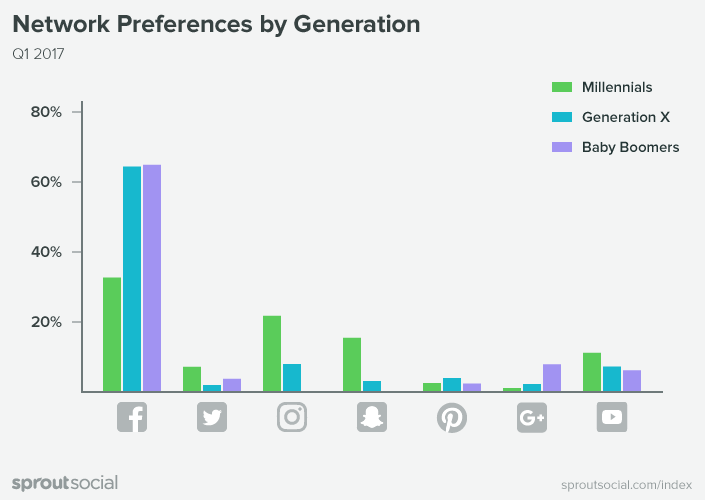
Social media network preference by generation. Source: SproutSocial, 2017
If you want to attract Millennials, the SproutSocial study clearly shows that you should focus your efforts on Instagram, Snapchat and YouTube—but Facebook should remain top-of-mind, still.
Why follow a brand on social media?
Millennials and Gen Xers are two times more likely to follow a brand on social media than Baby Boomers.

Percentage of people, by generation, that follow brands on social media. Source: SproutSocial, 2017
Why is there such a gap? According to the study:
- Millennials follow a brand in order to be entertained (38%) and get information (42%).
- Gen Xers follow a brand for contests (41%) or special offers and promotions (58%).
- Baby Boomers hover between the two other generations. They look for the right mix of deals and promotions (60%) and information (53%).
Millennials also interact with brands on social media twice as much than Gen Xers and Baby Boomers, which means that it’s a great communications tool to reach this target market (particularly on mobile devices!).
What incites generations to stop following a brand?
If generations don’t follow brands for the same reasons, it stands to reason that they unfollow a brand for different reasons as well.
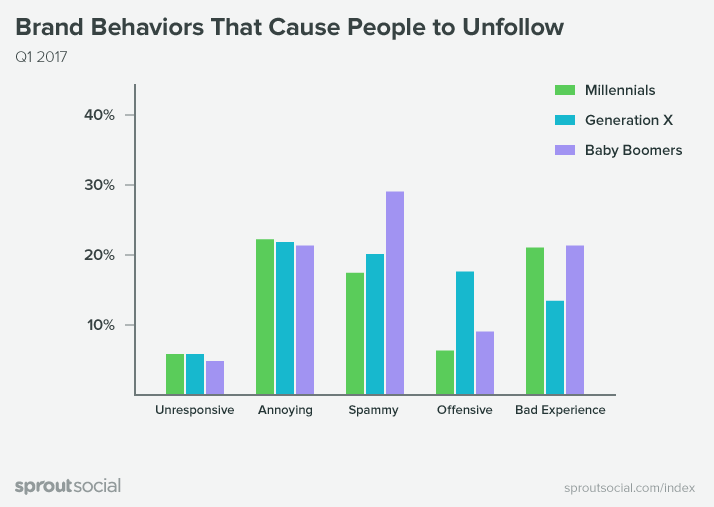
Reasons why generations stop following a brand on social media. Source: SocialSprout, 2017.
Gen Xers are 160% more likely than other generations to unfollow a brand on social media if it posts content that is offensive or against their personal values. Millennials stop following brands due to a bad experience (21%) or because the brand’s marketing or content are annoying (22%).
And Baby Boomers? They specifically hate spam, which incites 29% of them to unfollow a brand on social media.
Generation X: The generation that pays off big on social media!
Oftentimes, we describe Generation X as the lost generation—situated between Boomers and Millennials, which are bigger in numbers. However, when you look at spending habits, Gen Xers are more likely to spend with a brand that they follow on social media (7 out of 10).
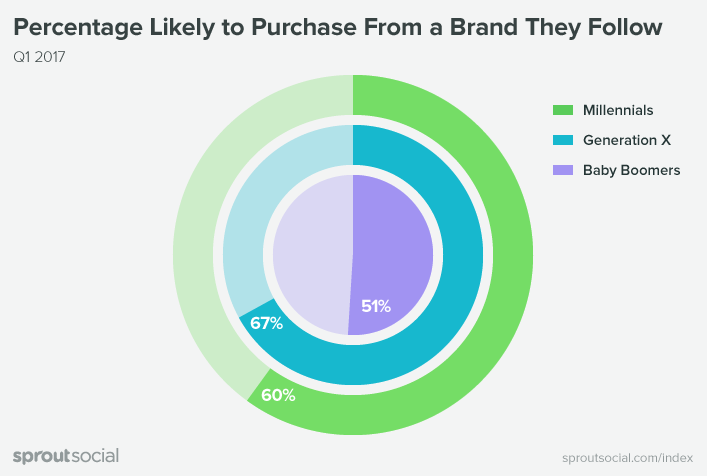
The likelihood people will buy from a brand they follow on social media, by generation. Source: SproutSocial, 2017
Note, however, that Millennials (60%) and Boomers (51%) also spend money on brands they follow on social media. That’s why it is so important to maintain a strong community on key social media networks where your target audiences are normally found.
Variations by industry
I really like this last table, because it shows KPIs per industry, which offers a telling tale on social media behaviour.
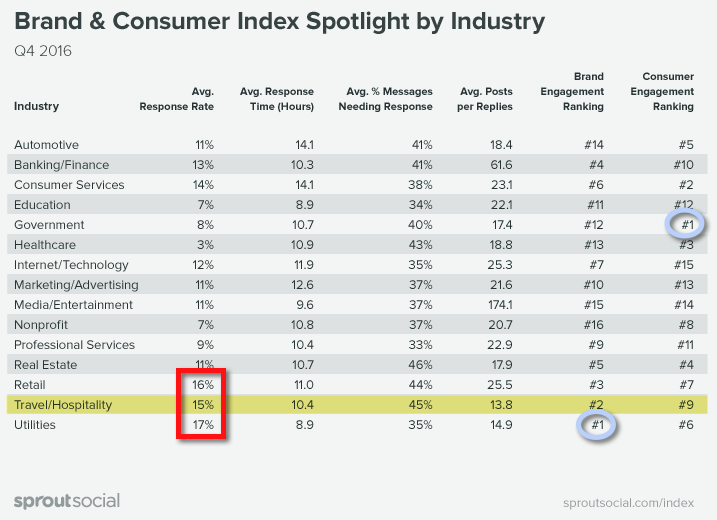
Social media KPIs, per industry. Source: SproutSocial, 2017
To better understand the results in this table, let’s take a closer look at each KPI:
Average response rate
This is the percentage of users that required a reply and got one! The retail, travel and utility industries obtain the best results overall. The worst performers? Businesses in the health sector, which only respond to 3% of consumer posts!
Average response time
This is the average number of hours that users must wait before getting a reply to a question or comment. The lower the number, the quicker the reply, which is what customers have come to expect. Hats off to brands in the educational, media/entertainment, and utilities sectors, which answer in less than 10 hours.
Average % messages needing response
This is the average number of messages requiring a response. It is calculated by SproutSocial’s algorithm, which is based on the number of mentions with a @ or question marks. The retail, real estate and tourism industries are the most solicited with respect to this KPI.
Average post per replies
This number represents the number of promotional messages posted by a brand compared with the number of replies given to followers. This column features the biggest discrepancies:
- The media and entertainment industry posts, on average 174 posts for each reply given. This stat definitely confirms the monologue that we all notice on Twitter and Facebook
- The banking and financial services industry are second, with 62 posts per reply.
- On the other end of the spectrum, the travel industry, utilities and governments post between 13 and 17 posts for each reply. These are more reasonable ratios, which focus more on giving information and inciting engagement, rather than all-out promoting their brands.
In a nutshell, brands in some industries are more proactive than others when responding to questions or comments from their communities. The top industries are utilities, travel and retail.
Consumer engagement ranking
This score indicates how vocal consumers are regarding a brand. Needless to say, people tend to be more vocal with governments, in the consumer services and healthcare sectors.
As I mentioned from the very beginning, these types of results must be taken with a grain of salt. Don’t make generalized assumptions about a generation or industry.
These results are nevertheless a benchmark you can use to determine the strategy and effectiveness of your social media initiatives with your target audiences.
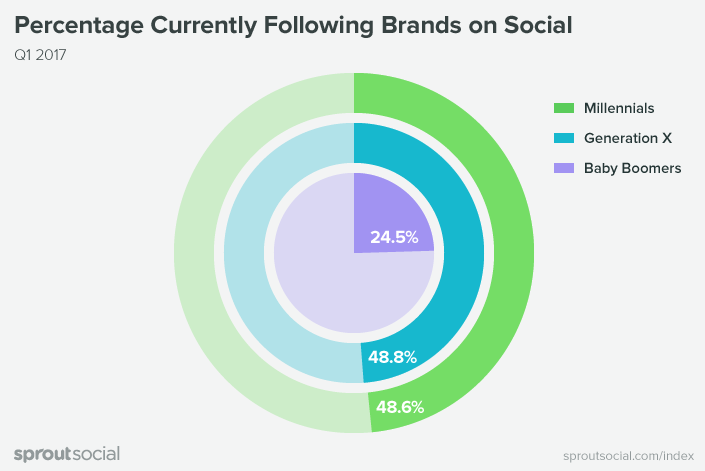


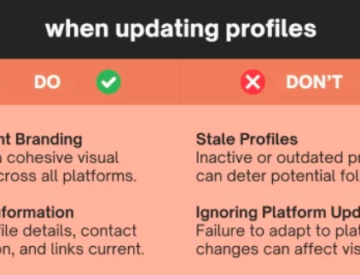






Leave a Reply